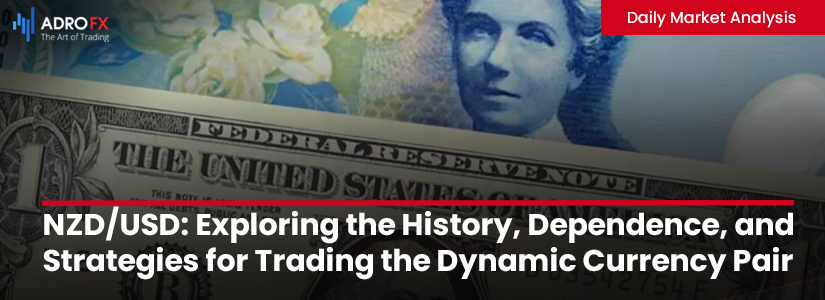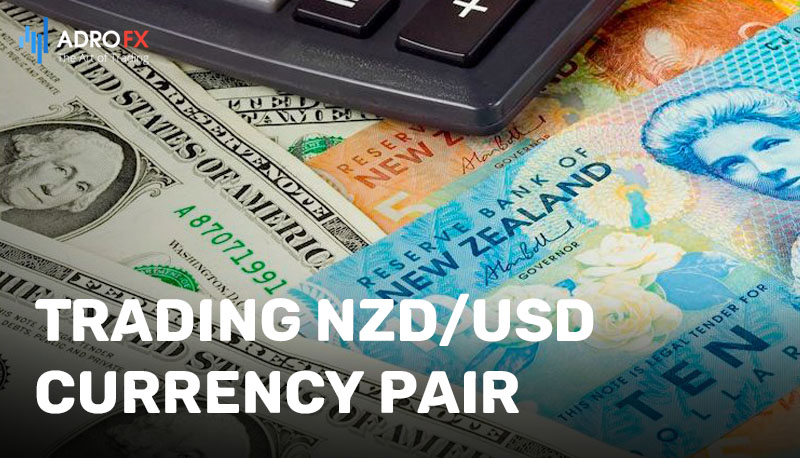NZD/USD: Exploring the History, Dependence, and Strategies for Trading the Dynamic Currency Pair

The NZD/USD currency pair holds a significant position in the global forex market, accounting for about 7% of all foreign exchange transactions. As a major pair, it attracts the attention of traders and investors seeking opportunities in the New Zealand dollar (NZD) and the US dollar (USD) exchange rate. Understanding the dynamics of this currency pair is crucial for those looking to engage in forex trading. In this article, we will explore the history of the NZD and its dependence on the USD, as well as provide strategies and tips for trading NZD/USD.
NZD/USD Explained
The New Zealand dollar against the US dollar is an instrument, which belongs to the category of so-called "major" since it accounts for about 7% of all foreign exchange transactions in the international market.
The NZD is the base currency, while the USD is convertible, i.e. we deal with an inverse exchange rate. Quotes show how much USD should be given for a single New Zealand dollar.
Currently, the pair has average volatility of around 65-100 pips per day, but in some periods it can go up to 200 and more. The most active trades usually take place during the European trading session, as well as during the New Zealand exchanges.
History of the NZD
The history of the New Zealand dollar (NZD) dates back to the early 19th century when New Zealand was still a British colony. Here is an overview of the key milestones in the history of the NZD:
Pre-Decimalization (1840-1967)
- British pounds, shillings, and pence were the official currency in New Zealand from its early days of colonization in 1840.
- Various privately issued banknotes and coins circulated alongside British currency.
- The New Zealand pound was introduced in 1840, which was equivalent in value to the British pound.
Decimalization and Introduction of the Dollar (1967)
- In July 1967, New Zealand decimalized its currency, adopting a decimal system with the New Zealand dollar as its new unit of currency.
- The new system introduced dollars and cents, with 100 cents equaling one dollar.
- The New Zealand dollar was pegged to the British pound until 1985.
Floating Exchange Rate (1985-Present)
- In 1985, the New Zealand government implemented a floating exchange rate system, allowing the value of the NZD to be determined by market forces.
- This move was part of an economic reform package aimed at liberalizing the New Zealand economy.
- Since then, the exchange rate of the NZD has been influenced by factors such as inflation, interest rates, trade balance, and global market conditions.
Coins and Banknotes
- New Zealand's currency is issued by the Reserve Bank of New Zealand.
- The first series of New Zealand dollar banknotes, featuring prominent New Zealand personalities and landscapes, was introduced in 1967.
- The design of banknotes has been updated over the years, with new security features and changes to the imagery.
- New Zealand coins include denominations of 10, 20, and 50 cents, as well as 1 and 2-dollar coins.
Currency Value
- The value of the New Zealand dollar has fluctuated over time.
- In the early 2000s, the NZD experienced a period of strength against major currencies, driven by factors such as high interest rates and a strong economy.
- However, the exchange rate can be influenced by various economic factors, such as international trade, interest rate differentials, and investor sentiment.
It's important to note that currency values are subject to change due to various economic factors, and the history of the NZD is an ongoing story that continues to evolve.
What Affects NZD/USD Quotes
Like the AUD, the NZD is considered a commodity currency, so the online chart of the pair is highly sensitive to price changes in gold, sheep's wool, timber, textiles, and especially milk - one of the main food products in New Zealand, which even has a separate dairy market that specializes only in its sale.
New Zealand exports most of its dried milk to China. Accordingly, any movement in the Chinese economy, such as a rise or slowdown in GDP, is very important because when demand for New Zealand products increases, the price of milk will also increase, which will raise the New Zealand dollar compared to its competitors. Note that this situation is very similar to the Australian dollar - Australia is also heavily dependent on the Chinese economy because it exports a third of its goods to China. That is why you will find many similar patterns between the NZD and AUD pairs.
The dairy index also called the GDT (Global Dairy Trade) index, is worth a look.
In addition to economic indicators and milk powder sales, you should also keep an eye on the Reserve Bank of New Zealand (RBNZ), which meets monthly. But sometimes RBNZ meetings and press conferences are held right after the Fed meeting and the FOMC report in the US, which prevents the NZD/USD from finding a certain direction.
When analyzing the pair's price, we should pay special attention to the CRB Index (Commodity Research Bureau Index), with which the currency is strongly correlated - if the CRB rose, the NZD/USD will soon rise in price and vice versa.
Tourism is another main product of the New Zealand economy, so as visiting New Zealand becomes less expensive it is expected that the economy will improve and the currency may strengthen.
Although New Zealand is one of the few countries where the agricultural sector is completely open to the international economy (without subsidies or tariffs), fluctuations in NZD USD quotes can occur for various reasons that have nothing to do with the local economy. New Zealand markets are the first to open a new trading day, and banks and traders can use this fact from time to time to position trades in anticipation of the events of the coming day.
The NZD is heavily dependent not only on commodity and commodity exports but also on the AUD and the Australian economy, the Kiwi is largely repeating its movement with a delay of several months. In general, the NZD rate is much easier to predict than the USD, EUR, or GBP. The other set of factors that should be considered when trading this pair is standard:
- Weather and climate;
- Regular economic reports of the USA and New Zealand;
- Monetary policy and interest rates;
- Trade balances.
NZD/USD is highly correlated with NZD/CHF - 90.4%, AUD/USD - 88.6%, AUD/SGD - 85.6%, NZD/JPY - 82.6%, AUD/CHF and AUD/JPY - 81.8%, NOK/JPY - 81.5%, and the Nikkei 225 index - 80%. The greatest inverse correlation is observed with EUR/NZD -92.3%, GBP/AUD -87.2%, EUR/AUD -84.9%, XAU/AUD - -78%, and others.
It's important to note that the relationship between the NZD and USD is complex, and the exchange rate is influenced by a wide range of factors. Currency markets are highly dynamic, and the NZD's dependence on the USD can change based on evolving economic conditions and global market trends.

Trading NZD/USD Currency Pair
Trading the NZD/USD currency pair on the forex market involves speculating on the exchange rate movements between the New Zealand dollar (NZD) and the US dollar (USD). Here are some strategies and tips to consider when trading NZD/USD:
Fundamental Analysis
- Stay updated on economic indicators, central bank policies, and news events that can impact both the NZD and USD.
- Monitor key economic data such as GDP, inflation rates, interest rate decisions, employment reports, and trade balance figures from both New Zealand and the United States.
- Analyze the market sentiment and any geopolitical factors that could affect the currency pair.
Technical Analysis
- Use technical analysis tools such as charts, trend lines, support and resistance levels, and indicators (e.g., moving averages, and oscillators) to identify patterns and potential entry or exit points.
- Look for price patterns, such as breakouts or reversals, that can provide trading opportunities.
- Apply risk management techniques, such as setting stop-loss orders to limit potential losses and take-profit orders to secure gains.
Correlations and Commodity Prices
- Consider the relationship between the NZD and commodity prices, particularly New Zealand's significant exports like dairy products.
- Monitor commodity price movements, as they can have a significant impact on the NZD/USD exchange rate.
Interest Rate Differential
- Pay attention to interest rate differentials between the Reserve Bank of New Zealand (RBNZ) and the US Federal Reserve.
- Changes in interest rates can affect the attractiveness of each currency, potentially influencing the NZD/USD exchange rate.
Risk Management
- Implement proper risk management techniques, such as determining the appropriate position size and setting stop-loss orders.
- Consider using leverage cautiously and be aware of the potential risks it carries.
- Diversify your trading portfolio to mitigate risk by trading multiple currency pairs.
Demo Trading and Education
- Before trading NZD/USD with real funds, practice with a demo account to familiarize yourself with the dynamics of the currency pair.
- Invest time in learning about forex trading, technical analysis, and fundamental analysis to enhance your trading skills and decision-making.
Stay Informed
- Stay updated with market news, economic calendars, and financial analysis to make informed trading decisions.
- Follow reputable sources for reliable information on economic developments and policy changes.
Remember that trading forex involves risks, and it's essential to develop a trading strategy based on your risk tolerance, financial goals, and trading experience. Consider consulting with a financial advisor or a professional trader for personalized guidance.
Conclusion
Trading the NZD/USD currency pair requires a comprehensive understanding of the factors that influence its exchange rate. Both fundamental and technical analysis play important roles in predicting future movements. Economic indicators, central bank policies, interest rate differentials, and commodity prices all impact the NZD/USD exchange rate. Risk management and staying informed are crucial elements of successful trading, and continuous education and practice are highly recommended. As with any trading endeavor, it is important to remember that forex trading involves risks, and it is advisable to consult with professionals or financial advisors to tailor strategies to individual risk profiles. By applying these strategies and tips, traders can enhance their chances of success when trading the NZD/USD currency pair in the dynamic forex market.
About AdroFx
Established in 2018, AdroFx is known for its high technology and its ability to deliver high-quality brokerage services in more than 200 countries around the world. AdroFx makes every effort to keep its customers satisfied and to meet all the trading needs of any trader. With the five types of trading accounts, we have all it takes to fit any traders` needs and styles. The company provides access to 115+ trading instruments, including currencies, metals, stocks, and cryptocurrencies, which make it possible to make the most out of trading on the financial markets. Considering all the above, AdroFx is the perfect variant for anyone who doesn't settle for less than the best.










